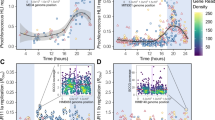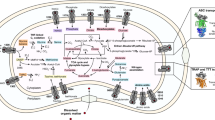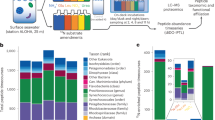Abstract
The northwestern Sargasso Sea undergoes annual cycles of productivity with increased production in spring corresponding to periods of upwelling, and oligotrophy in summer and autumn, when the water column becomes highly stratified. The biological productivity of this region is reduced during stratified periods as a result of low concentrations of phosphorus and nitrogen in the euphotic zone. To better understand the mechanisms of microbial survival in this oligotrophic environment, we used capillary liquid chromatography (LC)-tandem mass spectrometry to detect microbial proteins in surface samples collected in September 2005. A total of 2215 peptides that mapped to 236 SAR11 proteins, 1911 peptides that mapped to 402 Prochlorococcus proteins and 2407 peptides that mapped to 404 Synechococcus proteins were detected. Mass spectra from SAR11 periplasmic substrate-binding proteins accounted for a disproportionately large fraction of the peptides detected, consistent with observations that these extremely small cells devote a large proportion of their volume to periplasm. Abundances were highest for periplasmic substrate-binding proteins for phosphate, amino acids, phosphonate, sugars and spermidine. Proteins implicated in the prevention of oxidative damage and protein refolding were also abundant. Our findings support the view that competition for multiple nutrients in oligotrophic systems is extreme, but nutrient flux is sufficient to sustain microbial community activity.
Similar content being viewed by others
Log in or create a free account to read this content
Gain free access to this article, as well as selected content from this journal and more on nature.com
or
References
Adkins JN, Mottaz HM, Norbeck AD, Gustin JK, Rue J, Clauss TR et al. (2006). Analysis of the Salmonella typhimurium proteome through environmental response toward infectious conditions. Mol Cell Proteomics 5: 1450–1461.
Adkins JN, Varnum SM, Auberry KJ, Moore RJ, Angell NH, Smith RD et al. (2002). Toward a human blood serum proteome: analysis by multidimensional separation coupled with mass spectrometry. Mol Cell Proteomics 1: 947–955.
Anita NJ, Harrison PJ, Oliveira L . (1991). The role of dissolved organic nitrogen in phytoplankton nutrition, cell biology and ecology. Phycologia 30: 1–89.
Button DK . (1993). Nutrient-limited microbial growth kinetics: overview and recent advances. Antonie Van Leeuwenhoek 63: 225–235.
Button DK, Robertson B . (2000). Effect of nutrient kinetics and cytoarchitecture on bacterioplankter size. Limnol Oceanogr 45: 499–505.
Callister SJ, Dominguez MA, Nicora CD, Zeng X, Tavano CL, Kaplan S et al. (2006). Application of the accurate mass and time tag approach to the proteome analysis of sub-cellular fractions obtained from Rhodobacter sphaeroides 2.4.1. Aerobic and photosynthetic cell cultures. J Proteome Res 5: 1940–1947.
Carlson CA, Ducklow HW, Sleeter TD . (1996). Stocks and dynamics of bacterioplankton in the northwestern Sargasso Sea. Deep Sea Res II 43: 491–515.
Collier JL, Brahamsha B, Palenik B . (1999). The marine cyanobacterium Synechococcus sp. WH7805 requires urease (urea amidohydrolase, EC 3.5.1.5) to utilize urea as a nitrogen source: molecular-genetic and biochemical analysis of the enzyme. Microbiology 145: 447–459.
Cotner JB, Ammerman JW, Peele ER, Bentzen E . (1997). Phosphorus-limited bacterioplankton growth in the Sargasso Sea. Aquat Microb Ecol 13: 141–149.
Dayhoff MO . (1978). Atlas of Protein Sequence and Structure, Vol. 5, Supplement 3. National Biomedical Research Foundation: Washington, DC. p 348.
Ding YH, Hixson KK, Giometti CS, Stanley A, Esteve-Nunez A, Khare T et al. (2006). The proteome of dissimilatory metal-reducing microorganism Geobacter sulfurreducens under various growth conditions. Biochim Biophys Acta 1764: 1198–1206.
DuRand MD, Olson RJ, Chisholm SW . (2001). Phytoplankton population dynamics at the Bermuda Atlantic Time-series station in the Sargasso Sea. Deep Sea Res II 48: 1983–2003.
Dyhrman ST, Haley ST . (2006). Phosphorus scavenging in the unicellular marine diazotroph Crocosphaera watsonii. Appl Environ Microbiol 72: 1452–1458.
Ehlers MM, Cloette TE . (1999). Comparing the protein profiles of 21 different activated sludge systems after SDS-PAGE. Wat Res 33: 1181–1186.
Elias DA, Tollaksen SL, Kennedy DW, Mottaz HM, Giometti CS, McLean JS et al. (2008). The influence of cultivation methods on Shewanella oneidensis physiology and proteome expression. Arch Microbiol 189: 313–324.
Eng J, McCormack AL, Yates III JR . (1994). An approach to correlate tandem mass spectral data of peptides with amino acid sequences in a protein database. J Am Soc Mass Spectrom 5: 976–989.
Field KG, Gordon D, Wright T, Rappe M, Urback E, Vergin K et al. (1997). Diversity and depth-specific distribution of SAR11 cluster rRNA genes from marine planktonic bacteria. Appl Environ Microbiol 63: 63–70.
Forward JA, Behrendt MC, Wyborn NR, Cross R, Kelly DJ . (1997). TRAP transporters: a new family of periplasmic solute transport systems encoded by the dctPQM genes of Rhodobacter capsulatus and by homologs in diverse gram-negative bacteria. J Bacteriol 179: 5482–5493.
Frias-Lopez J, Shi Y, Tyson GW, Coleman ML, Schuster SC, Chisholm SW et al. (2008). Microbial community gene expression in ocean surface waters. Proc Natl Acad Sci USA 105: 3805–3810.
Fuhrman JA, Schwalbach MS, Stingl U . (2008). Proteorhodopsins: an array of physiological roles? Nat Rev Microbiol 6: 488–494.
Giovannoni SJ, Bibbs L, Cho JC, Stapels MD, Desiderio R, Vergin KL et al. (2005a). Proteorhodopsin in the ubiquitous marine bacterium SAR11. Nature 438: 82–85.
Giovannoni SJ, Tripp HJ, Givan S, Podar M, Vergin KL, Baptista D et al. (2005b). Genome streamlining in a cosmopolitan oceanic bacterium. Science 309: 1242–1245.
Guler S, Seeliger A, Hartel H, Renger G, Benning C . (1996). A null mutant of Synechococcus sp. PCC7942 deficient in the sulfolipid sulfoquinovosyl diacylglycerol. J Biol Chem 271: 7501–7507.
Gygi SP, Rochon Y, Franza BR, Aebersold R . (1999). Correlation between protein and mRNA abundance in yeast. Mol Cell Biol 19: 1720–1730.
Heldal M, Scanlan DJ, Norland S, Thingstad F, Mann NH . (2003). Elemental composition of single cells of various strains of marine prochlorococcus and synechococcus using X-Ray microanalysis. Limnol Oceanogr 48: 1732–1743.
Hirsch P, Bernhard M, Cohen SS, Ensign JC, Jannasch HW, Koch AL et al. (1979). Life under conditions of low nutrient concentrations. In: Shilo M (ed). Strategies of Microbial Life in Extreme Environments: report of the Dahlem Workshop on Strategy of Life in Extreme Environments, Berlin, 1978, November 20–24 Weinheim Verlag Chemie: New York. p 513.
Hixson KK, Adkins JN, Baker SE, Moore RJ, Chromy BA, Smith RD et al. (2006). Biomarker candidate identification in Yersinia pestis using organism-wide semiquantitative proteomics. J Proteome Res 5: 3008–3017.
Holtmann G, Bremer E . (2004). Thermoprotection of Bacillus subtilis by exogenously provided glycine betaine and structurally related compatible solutes: Involvement of Opu transporters. J Bacteriol 186: 1683–1693.
Igarashi K, Kashiwagi K . (1999). Polyamine transport in bacteria and yeast. Biochem J 344: 633–642.
Kan J, Hanson TE, Ginter JM, Wang K, Chen F . (2005). Metaproteomic analysis of Chesapeake Bay microbial communities. Saline Systems 1: 7.
Keller A, Nesvizhskii AI, Kolker E, Aebersold R . (2002). Empirical statistical model to estimate the accuracy of peptide identifications made by MS/MS and database search. Anal Chem 74: 5383–5392.
Kolowith LC, Ingall ED, Benner R . (2001). Composition and cycling of marine organic phosphorus. Limnol Oceanogr 46: 309–320.
Lacerda CM, Choe LH, Reardon KF . (2007). Metaproteomic analysis of a bacterial community response to cadmium exposure. J Proteome Res 6: 1145–1152.
Lipschultz F . (2001). A time-series assessment of the nitrogen cycle at BATS. Deep Sea Res II 48: 1897–1924.
Lo I, Denef VJ, Verberkmoes NC, Shah MB, Goltsman D, DiBartolo G et al. (2007). Strain-resolved community proteomics reveals recombining genomes of acidophilic bacteria. Nature 446: 537–541.
Lomas MW, Swain A, Shelton R, Ammerman JW . (2004). Taxonomic variability of phosphorus stress in Sargasso Sea phytoplankton. Limnol Oceanogr 49: 2303–2309.
Ludwig W, Strunk O, Klugbauer S, Klugbauer N, Weizenegger M, Neumaier J et al. (1998). Bacterial phylogeny based on comparative sequence analysis. Electrophoresis 19: 554–568.
Ludwig W, Strunk O, Westram R, Richter L, Meier H, Yadhukumar et al. (2004). ARB: a software environment for sequence data. Nucleic Acids Res 32: 1363–1371.
Malmstrom RR, Kiene RP, Cottrell MT, Kirchman DL . (2004). Contribution of SAR11 bacteria to dissolved dimethylsulfoniopropionate and amino acid uptake in the North Atlantic ocean. Appl Environ Microbiol 70: 4129–4135.
Martiny AC, Coleman ML, Chisholm SW . (2006). Phosphate acquisition genes in Prochlorococcus ecotypes: evidence for genome-wide adaptation. Proc Natl Acad Sci USA 103: 12552–12557.
McKay RML, Gibbs SP, Espie GS . (1993). Effect of dissolved inorganic carbon on the expression of carboxysomes, localization of Rubisco and the mode of inorganic carbon transport in cells of the cyanobacterium Synechococcus UTEX. Arch Microbiol 159: 21–29.
Mills MM, Moore CM, Langlois R, Milne A, Achterberg E, Nachtigall K et al. (2008). Nitrogen and phosphorus co-limitation of bacterial productivity and growth in the oligotrophic subtropical North Atlantic. Limnol Oceanogr 53: 824–834.
Moore LR, Post AF, Rocap G, Chisholm SW . (2002). Utilization of different nitrogen sources by the marine cyanobacteria Prochlorococcus and Synechococcus. Limnol Oceanogr 47: 989–996.
Morris RM, Rappe MS, Connon SA, Vergin KL, Siebold WA, Carlson CA et al. (2002). SAR11 clade dominates ocean surface bacterioplankton communities. Nature 420: 806–810.
Morris RM, Vergin KL, Cho JC, Rappe MS, Carlson CA, Giovannoni SJ . (2005). Temporal and spatial response of bacterioplankton lineages to annual convective overturn at the Bermuda Atlantic Time-series Study site. Limnol Oceanogr 50: 1687–1696.
Nicastro D, Schwartz C, Pierson J, Cho J-C, Giovannoni SJ, McIntosh JR . (2006). Three-dimensional structure of the tiny bacterium Pelagibacter ubique studied by cryo-electron tomography. Micros Microanal 12: 180–181.
Poretsky RS, Bano N, Buchan A, LeCleir G, Kleikemper J, Pickering M et al. (2005). Analysis of microbial gene transcripts in environmental samples. Appl Environ Microbiol 71: 4121–4126.
Ram RJ, Verberkmoes NC, Thelen MP, Tyson GW, Baker BJ, Blake II RC et al. (2005). Community proteomics of a natural microbial biofilm. Science 308: 1915–1920.
Rappe MS, Connon SA, Vergin KL, Giovannoni SJ . (2002). Cultivation of the ubiquitous SAR11 marine bacterioplankton clade. Nature 418: 630–633.
Rivkin RB, Anderson MR . (1997). Inorganic nutrient limitation of oceanic bacterioplankton. Limnol Oceanogr 42: 730–740.
Scanlan DJ, Silman NJ, Donald KM, Wilson WH, Carr NG, Joint I et al. (1997). An immunological approach to detect phosphate stress in populations and single cells of photosynthetic picoplankton. Appl Environ Microbiol 63: 2411–2420.
Schulze WX, Gleixner G, Kaiser K, Guggenberger G, Mann M, Schulze ED . (2005). A proteomic fingerprint of dissolved organic carbon and of soil particles. Oecologia 142: 335–343.
Sedwick PN, Church TM, Bowie AR, Marsay CM, Ussher SJ, Achilles KM et al. (2005). Iron in the Sargasso Sea (Bermuda Atlantic Time-series Study region) during summer: Eolian imprint, spatiotemporal variability, and ecological implications. Global Biogeochem Cycles 19: 1–11.
Sieracki ME, Haugen EM, Cucci TL . (1995). Overestimation of heterotrophic bacteria in the Sargasso Sea: direct evidence by flow and imaging cytometry. Deep Sea Res I 42: 1399–1409.
Sowell SM, Norbeck AD, Lipton MS, Nicora CD, Callister SJ, Smith RD et al. (2008). Proteomic analysis of stationary phase in the marine bacterium ‘Candidatus Pelagibacter ubique’. Appl Environ Microbiol 74: 4091–4100.
Steinberg DK, Carlson CA, Bates NR, Johnson RJ, Michaels AF, Knap AH . (2001). Overview of the US JGOFS Bermuda Atlantic Time-series Study (BATS): a decade-scal look at ocean biology and biogeochemistry. Deep Sea Res II 48: 1405–1447.
Sumper M, Brunner E, Lehmann G . (2005). Biomineralization in diatoms: characterization of novel polyamines associated with silica. FEBS Lett 579: 3765.
Tripp HJ, Kitner JB, Schwalbach MS, Dacey JWH, Wilhelm LJ, Giovannoni SJ . (2008). SAR11 marine bacteria require exogenous reduced sulfur for growth. Nature 452: 741–744.
Van Mooy BA, Rocap G, Fredricks HF, Evans CT, Devol AH . (2006). Sulfolipids dramatically decrease phosphorus demand by picocyanobacteria in oligotrophic marine environments. Proc Natl Acad Sci USA 103: 8607–8612.
Venter JC, Remington K, Heidelberg JF, Halpern AL, Rusch D, Eisen JA et al. (2004). Environmental genome shotgun sequencing of the Sargasso Sea. Science 304: 66–74.
Wanner BL . (1996). Phosphorus assimilation and control of the phosphate regulon. In: Neidhardt FC (ed). Escherichia coli and Salmonella Typhimurium: Cellular and Molecular Biology. ASM Press: Washington, DC. pp 1357–1381.
Washburn MP, Wolters D, Yates III JR . (2001). Large-scale analysis of the yeast proteome by multidimensional protein identification technology. Nat Biotechnol 19: 242–247.
Wilhelm LJ, Tripp HJ, Givan SA, Smith DP, Giovannoni SJ . (2007). Natural variation in SAR11 marine bacterioplankton genomes inferred from metagenomic data. Biol Direct 2: 27.
Wilmes P, Bond PL . (2004). The application of two-dimensional polyacrylamide gel electrophoresis and downstream analyses to a mixed community of prokaryotic microorganisms. Environ Microbiol 6: 911–920.
Woodger FJ, Badger MR, Price GD . (2003). Inorganic carbon limitation induces transcripts encoding components of the CO(2)-concentrating mechanism in Synechococcus sp. PCC7942 through a redox-independent pathway. Plant Physiol 133: 2069–2080.
Wu J, Sunda W, Boyle EA, Karl DM . (2000). Phosphate depletion in the western North Atlantic Ocean. Science 289: 759–762.
Zubkov MV, Fuchs BM, Tarran GA, Burkill PH, Amann R . (2003). High rate of uptake of organic nitrogen compounds by Prochlorococcus cyanobacteria as a key to their dominance in oligotrophic oceanic waters. Appl Environ Microbiol 69: 1299–1304.
Zubkov MV, Mary I, Woodward EMS, Warwick PE, Fuchs BM, Scanlan DJ et al. (2007). Microbial control of phosphate in the nutrient-depleted North Atlantic subtropical gyre. Environ Microbiol 9: 2079–2089.
Acknowledgements
We thank the scientists and staff of the Bermuda Atlantic Time-series Study Site for their assistance and support; specifically, the crew of the Weatherbird II for their help in sample collection and Rachel Parsons for her technical and administrative assistance. We also thank Dr Allen Milligan for sharing his expertize. This work was supported by a Marine Microbiology Initiative Investigator Award from the Gordon and Betty Moore Foundation. Portions of this research were also supported by the US Department of Energy (DOE) Office of Biological and Environmental Research and performed at the Environmental Molecular Science Laboratory, a DOE national scientific user facility located at Pacific Northwest National Laboratory.
Author information
Authors and Affiliations
Corresponding author
Additional information
Supplementary Information accompanies the paper on The ISME Journal website (http://www.nature.com/ismej)
Rights and permissions
About this article
Cite this article
Sowell, S., Wilhelm, L., Norbeck, A. et al. Transport functions dominate the SAR11 metaproteome at low-nutrient extremes in the Sargasso Sea. ISME J 3, 93–105 (2009). https://doi.org/10.1038/ismej.2008.83
Received:
Revised:
Accepted:
Published:
Issue date:
DOI: https://doi.org/10.1038/ismej.2008.83
Keywords
This article is cited by
-
Seasonal patterns in microbial carbon and iron transporter expression in the Southern Ocean
Microbiome (2023)
-
Tracking nitrogen allocation to proteome biosynthesis in a marine microbial community
Nature Microbiology (2023)
-
Functional annotation and importance of marine bacterial transporters of plankton exometabolites
ISME Communications (2023)
-
Novel functional insights into a modified sugar-binding protein from Synechococcus MITS9220
Scientific Reports (2022)
-
Rapid bacterioplankton transcription cascades regulate organic matter utilization during phytoplankton bloom progression in a coastal upwelling system
The ISME Journal (2022)



